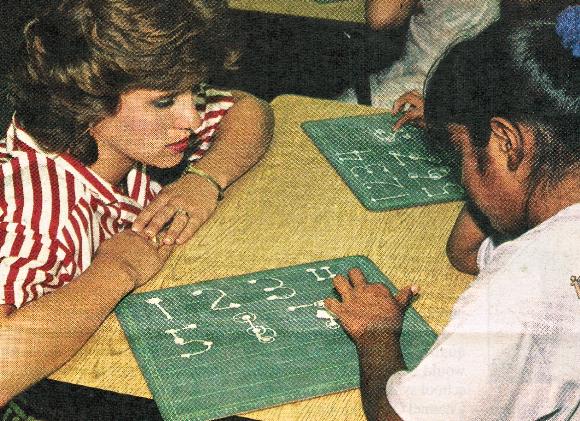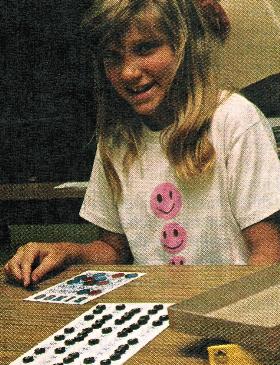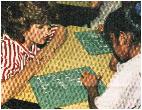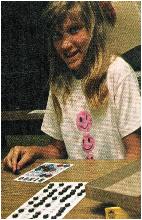
“K-12 change is pushing the university to think about its role in teacher preparation,” says Lappan. “I’m pleased to see the university responding to the challenge. The univer-sity community is taking this seriously.”
Indeed, the evidence about the current state of math achievement in America shows our country trailing behind most of our industrialized counterparts. Reform is “critical,” says University of Houston – Victoria president Glen Goerke, who lauds and supports Shoecraft’s changes. “I think we’ve ignored the fact that what we’re doing just does not work, and we can’t continue.
“Math is a base for so many other things . . . . If we’re going to have American students achieve at a [higher] level in math and science, we’ve got to change some things.”
What teachers say about Move It!
This summer, On Campus visited Shoecraft’s three-week “multi-modality, sensory-based” math program as it was being presented to teachers from 10 rural school districts in Texas. In addition to bringing teachers up to speed on the latest curriculum and instructional developments, the program also provided real live kids on which the teachers could practice their new techniques. The teachers’ enthusiasm was catching.
“I saw teachers change their opinion of math in the first day,” says Sue Gottwald, director of elementary education in the Gonzales, Texas, independent school district. “They no longer think math has to be memorized.”
Principal Don Rainey of the North Avenue Elementary School in Gonzales says he is sold on the concept and has seen it improve the performance of third-grade students who previously scored poorly on achievement tests. “If my teachers are willing to commit the time to [learn how to use the program], so am I.”
Pre-K teacher Lynn Gescheidle of Gonzales, Texas, is trying out the methods on some young and willing participants. “The touch-counting method gives kids a xxx
The games, objects, examples and hands-on activities make numbers real to children. The manipulatives that Move It! math uses are developmentally appropriate, says Shoecraft. And there are plenty of them: “balance beams” that look like colorful weight scales with a number line and “tags” that can be hung on either side to illustrate equality and blocks that teach the concept of “fair trades” … in different number bases.
These tools are designed to meet children’s perception of reality. The traditional curriculum does not reflect a “broad enough view of the literature,” Shoecraft maintains. “There’s a million things written out there, and you have to keep at least two ideas in mind at a time to catch [what matters].”
Figuring out what works
The declining mathematics achievement of America’s preadolescents was what triggered Shoecraft’s concern about the quality of math teaching. Why, he wondered, were kids having so much trouble? What he found was that kids weren’t the only ones floundering. Their teachers were, too.
“The average elementary school teacher has had less that one course in math or science,” explains Robert Nielsen, special assistant to the AFT president and a former professor of mathematics, “and that course was probably a methods course.” Nielsen has taught in the Move It! math program. “These teachers will tell you that the reason they became elementary school teachers is because they were weak in math or science.
“Shoecraft sees that they learn enough mathematics—both the Move It! math and the math theory behind it—to discover math themselves, in much the same way that the kids discover math. Then they develop the enthusiasm to teach their students and their colleagues.”
Nielsen adds that the teachers-teaching-teachers aspect of the program is vital to its success. “You can’t get all the elementary teachers to go back to school, so teaching teachers to teach each other has a nice multiplier effect.”
Shoecraft’s program is one of several cropping up around the country that could revolutionize the teaching of math, says Glenda Lappan, National Science Foundation (NSF) director for teacher preparation programs. The programs that NSF is funding range from those that could reform instructional practice to bring coherence to both math and science teaching, to those where the computer is central. These latter programs use computer technology to bring real classes of children and their teachers [together] in the university classroom. Lappan, who also sits on the National Council of Teachers of Mathematics’ board, explains that reform efforts are focused on changing mathematics curricula and instruction standards.…


Through “Fair Trades,” a student learns the idea behind addition and subtraction by carrying and borrowing.
Instead of leaving kids at the mercy of abstract numbers, counting techniques like “Tap and Tally” give kids power over numbers.
Next > | New Math Formula | Kindermath | Demonstration | Federal Funding | Inservice Funded | Anyone Can Learn Math | Summer Volunteers | Monster Math | Making Math Fun | Area Leaders | New Math of 90s | Video | MOVE IT! | Math Made Easy | VIPS to View Pgm | Gov. Richards | Richard's Attention | Revolution | Adds Up | Mexico | Letter | Atlanta 2003 | < Back — HOME

